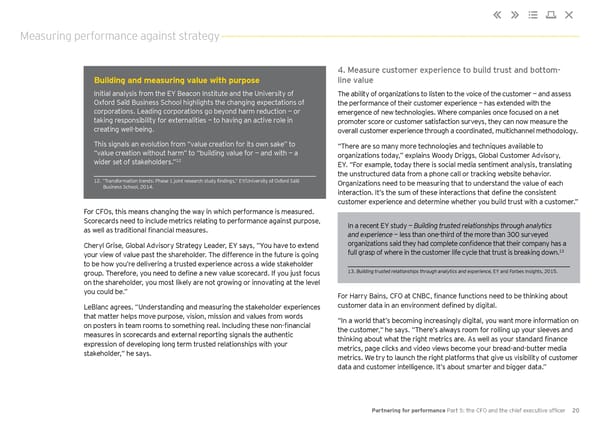Measuring performance against strategy 4. Measure customer experience to build trust and bottom- Building and measuring value with purpose line value Initial analysis from the EY Beacon Institute and the University of The ability of organizations to listen to the voice of the customer — and assess Oxford Saïd Business School highlights the changing expectations of the performance of their customer experience — has extended with the corporations. Leading corporations go beyond harm reduction — or emergence of new technologies. Where companies once focused on a net taking responsibility for externalities — to having an active role in promoter score or customer satisfaction surveys, they can now measure the creating well-being. overall customer experience through a coordinated, multichannel methodology. This signals an evolution from “value creation for its own sake” to “There are so many more technologies and techniques available to “value creation without harm” to “building value for — and with — a organizations today,” explains Woody Driggs, Global Customer Advisory, 12 wider set of stakeholders.” EY. “For example, today there is social media sentiment analysis, translating the unstructured data from a phone call or tracking website behavior. 12. “Transformation trends: Phase 1 joint research study findings,” EY/University of Oxford Saïd Organizations need to be measuring that to understand the value of each Business School, 2014. interaction. It’s the sum of these interactions that define the consistent customer experience and determine whether you build trust with a customer.” For CFOs, this means changing the way in which performance is measured. Scorecards need to include metrics relating to performance against purpose, In a recent EY study — Building trusted relationships through analytics as well as traditional financial measures. and experience — less than one-third of the more than 300 surveyed Cheryl Grise, Global Advisory Strategy Leader, EY says, “You have to extend organizations said they had complete confidence that their company has a 13 your view of value past the shareholder. The difference in the future is going full grasp of where in the customer life cycle that trust is breaking down. to be how you’re delivering a trusted experience across a wide stakeholder group. Therefore, you need to define a new value scorecard. If you just focus 13. Building trusted relationships through analytics and experience, EY and Forbes Insights, 2015. on the shareholder, you most likely are not growing or innovating at the level you could be.” For Harry Bains, CFO at CNBC, finance functions need to be thinking about LeBlanc agrees. “Understanding and measuring the stakeholder experiences customer data in an environment defined by digital. that matter helps move purpose, vision, mission and values from words “In a world that’s becoming increasingly digital, you want more information on on posters in team rooms to something real. Including these non-financial the customer,“ he says. “There’s always room for rolling up your sleeves and measures in scorecards and external reporting signals the authentic thinking about what the right metrics are. As well as your standard finance expression of developing long term trusted relationships with your metrics, page clicks and video views become your bread-and-butter media stakeholder,“ he says. metrics. We try to launch the right platforms that give us visibility of customer data and customer intelligence. It’s about smarter and bigger data.” Partnering for performance Part 5: the CFO and the chief executive officer 20
 Partnering for Performance Part 5 Page 21 Page 23
Partnering for Performance Part 5 Page 21 Page 23